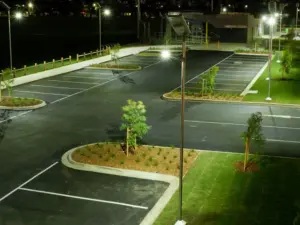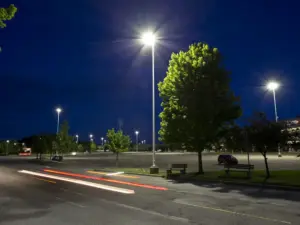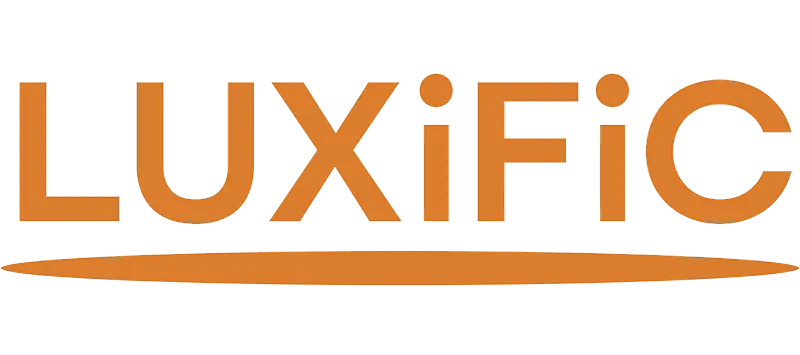Introduction:
Parking lots are busy places. To make them inviting and secure, paying attention to light them up is a must. In city planning and safety, making parking lots well-lit is crucial. Good parking lot lighting design is about making sure drivers and walkers feel safe. The following is a complete guide.
Parking Lot Lighting Design Guide

1. Avoiding Too Much Light and Following Rules
While having a bright space is important, we also need to be mindful of light pollution and follow the rules. LED parking lot lights are great for this because they point light where it’s needed, not everywhere. Following local and industry rules ensures we are taking care of the environment.
2. Balancing Looks with Practicality
Besides safety, a well-designed parking lot should look good. The right lights can make the space appealing while doing their job well. Balancing these two aspects is important. It turns a parking lot from a practical space into an inviting area that adds to the surroundings.
3. Choose the Suitable Parking Lot Lights
Choosing the right lights for a parking lot is crucial. Different situations call for different solutions. Understanding the benefits of LED, metal halide, and high-pressure sodium lights is key.
Advantages of LED Parking Lot Lights

LED parking lot lights are the top choice for parking lots, and there’s a good reason for that. They use less energy, last longer, and can direct light where it’s needed. LED parking lot lights not only save electricity but also make the light spread out more.
Considering Metal Halide Lights
Metal halide lights still have their place, especially in certain parking lot situations. Knowing what different spaces need and the colors these lights show is important.
Exploring High-Pressure Sodium Lights
High-pressure sodium lights have their advantages, especially in specific conditions. Checking if they suit the unique needs of a parking lot ensures an approach to lighting design.
4. Where to Put the Parking Lot Lights?

Figuring out the best spots for lights is crucial. Odd-shaped parking lot lights pose challenges. We need smart solutions to make sure the light is good enough.
Smart Placement of Lights
Putting parking lot light poles in smart places means looking at how the parking lot is set up. Identifying busy spots, walkways, and areas that might be less safe guides us. The aim is to get rid of dark corners and provide good lighting across the whole parking area. Thus, be aware of where you put parking lot light poles.
Solving Issues in Oddly-Shaped Lots
Odd-shaped parking lots need creative lighting solutions. Placing lights, thinking about how traffic moves. Consider any obstacles to ensure that every corner gets enough light. This customized approach helps with both safety and efficiency.
Making Light Spread Out
Having even lighting is a must in parking lot design. Make sure the light levels are consistent throughout the space. It improves safety and looks. Being careful about where we put the lights and understanding of odd shapes helps.
5. Thinking Green in Parking Lot Lighting Design
At this time, parking lot lighting requirements need to follow energy-efficient principles. Use smart controls and renewable energy. Thinking about the cost over time is important in a green approach.
Using Smart Controls for Lights
Smart controls are a modern way to save energy. Adding sensors and automation means lights are on only when needed. This saves energy and also makes lights last longer, contributing to long-term sustainability.
Adding Renewable Energy
Going a step further in sustainability involves looking at renewable energy sources. Solar-powered lights. Using the sun’s power to light up parking lot lights not only cuts reliance on regular power but also lowers costs.
Considering the Full Cost Over Time
Thinking about costs upfront is important. Looking at how much the lights will cost over time is crucial. LED lights, known for lasting long and being energy-efficient, end up being cheaper. This helps balance immediate costs with the long-term impact of our lighting choices.
6. Following Rules and Standards
Understanding and following rules is a must in parking lot lighting design. Local and industry guidelines need careful consideration to be compliant. It ensures safety and environmental standards are there.
Knowing Local and Industry Rules
Design lighting that follows the law. We need to understand local rules and industry standards. From how much light is there to rules about where light can’t spill, knowing these helps us design.
7. Importance of Lighting Professionals
In parking lot lighting design, experience matters. Working with lighting professionals brings a wealth of knowledge. From staying updated on the latest rules to finding new solutions. Their input is valuable in creating a lighting design that is safe and sustainable.
Parking Lot Lighting Design- Challenges and Solutions
Meeting common design challenges is important for creating effective parking lot lighting requirements. Figure out solutions for issues in different parking lot situations. It ensures a well-thought-out and adaptable approach.
Common Design Issues
Common problems like glare, uneven lighting, and maintenance need specific answers. Use anti-glare fixtures and place lights to avoid shadows. Also, choosing lights that need less maintenance deals with these issues. Thinking ahead about possible problems helps designers create strong lighting solutions that last.
Solving Problems in Different Situations
Different parking lots have different issues. From crowded city spaces to large suburban lots. Making lighting solutions that fit each situation means using smart light placement. It also includes adaptable technology and understanding how people use these spaces. By planning for these issues, parking lot lighting requirements can serve well.
Top Trends of Parking Lot Lighting Design
Connected Lighting Systems
Connected lighting systems are transforming parking lot lighting design. These smart systems can adjust light levels based on real-time conditions. These are things such as traffic flow, weather, and time of day. It enhances energy efficiency. It also creates a responsive and dynamic lighting environment. That contributes to safer and more efficient parking lots.
Creative Lighting Elements
Parking lot lighting is evolving beyond functionality to become creative. Designers are incorporating creative elements like accent lighting and color temperature variations. Also, architectural lighting features enhance the visual appeal of parking lots. It is for transforming them into engaging spaces.
Compliance with Dark Sky Standards
The awareness of light pollution is driving a trend toward compliance with this. Designers are mindful of minimizing unnecessary light spillage. Using LED lighting is a preferred choice for its directional illumination. It aligns with dark sky principles.
Customized Solutions for Shaped Lots
Parking lots come in multiple shapes and sizes. There is a trend emerging toward customized lighting solutions for shaped lots. Designers are employing creative placement of fixtures, considering traffic flow and potential obstacles. The aim is to ensure that every corner receives adequate illumination. Contributing to both safety and efficiency.
Conclusion:
Effective parking lot lighting design is more than about seeing. It is a mix of safety, sustainability, and making things look good. Focus on key goals, understand lighting types, plan where lights go, use energy-efficient practices, and follow the rules. You can create lighting solutions that keep parking lots safe and efficient. Do not forget about LED parking lot light fixtures.
